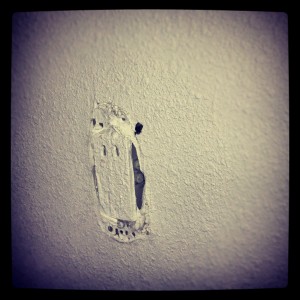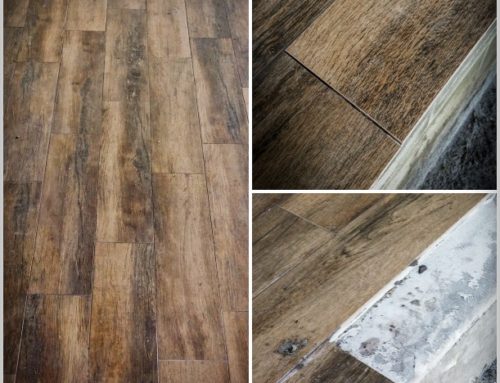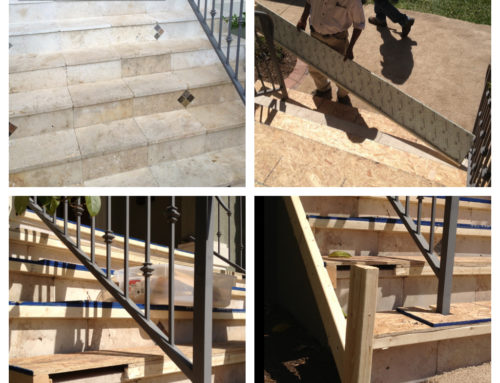
Original Electrical Outlet Left In Place In Remediated Chinese Drywall Home. This is a good clue, definitive evidence really, that this home has not been remediated properly.
Should You Buy A Chinese Drywall Home In Tampa Bay? Well, it depends.
If remediated correctly, a home that previously had Chinese drywall can in many respects be considered to be better – and even more valuable – than similar non-Chinese drywall homes in the same neighborhood (see Part 2 of this article Should I Buy A Chinese Drywall Home? – Tampa, Florida). However, an improperly remediated home should essentially be considered to have never been remediated at all. Knowing the difference between a properly remediated home, and an improperly remediated one, makes all the difference in deciding whether you should purchase a Chinese drywall home.
In addition to our work as a Tampa Chinese drywall remediation contractor working throughout Tampa Bay (Florida), we also frequently find ourselves offering advise and consulting services to homeowners with Chinese drywall who are considering remediating, and also to buyers who are considering purchasing homes that have, or had, Chinese drywall.
The purpose of this article is to share some of our observations from a recent inspection of a remediated (used very loosely in this case) home for a potential buyer (our client). This home was so poorly remediated that my final conclusion and advice was that the home should be considered to have never been remediated at all. This article should be valuable to those who are interested in buying a home that has, or had, Chinese drywall; and also for those homeowners who are considering having their own homes remediated, and want to ensure they do not make mistakes that will ultimately lower the sale price of their home when they sell it in the future.
The home we inspected was owned by a bank. The bank had remediated the home, and put it back onto the market for sale. Before walking the home, our client emailed us an inspection report that was provided to them by the bank. The inspection report – which had some glaring omissions – had been done by a somewhat prominent company advertising their Chinese drywall inspection and remediation services on the west coast of Florida. Their inspection was performed after the home had been “remediated”, and new drywall and trim had been installed in the house. At the time of their inspection all cabinets, countertops, toilets, etc were also placed back into the home.
Upon review of the report it was immediately obvious that the home had not been remediated properly. One of the photos included in the report showed a pile of Chinese drywall debris (complete with the “Made In China” labels) on the floor of the attached garage floor. This alone represents a major breach of acceptable Chinese drywall remediation and cleaning protocols.
The most basic acceptable standard for a Chinese drywall remediation is that 100% off all Chinese drywall boards, pieces, marks, debris, and dust have been removed from the home before rebuilding can begin. This is a fundamental requirement. Yes, there are other considerations, not least of which are the protocols established by the Consumer Product Safety Commission Task Force, and Judge Fallon, (See our Chinese Drywall Remediation Protocol Comparison – Part 1, and Chinese Drywall Remediation Protocol Comparison – Part 2 articles), but 100% removal must regarded as the minimum requirement.
Using the fundamental standard of 100% removal, and observing the photos of the remediated home with Chinese drywall piled up in the garage, we already knew that whoever performed the remediation on this home either did not know what they were doing, or chose to cut corners to do the remediation as cheaply as possible, or both. The nature of construction is such that dust from the Chinese drywall in the garage would very easily be tracked back into the home, which would then re-contaminate the cleaned home (this assumes the home was ever clean to start with). This major breach in protocol means it is extremely likely (99.99% likely in my mind) that the areas now hidden behind the new drywall are all completely contaminated with Chinese drywall pieces, debris, and dust that were never completely removed from the home to start with. Although the newly installed drywall prevented us from directly verifying some of these concerns, there were other clues within the home that further corroborated the improper remediation:
- In addition to the major red flag raised from the previous inspection report, our onsite inspection confirmed that the standards for remediation had been pathetic at best. An inspection of the attic space confirmed that the trusses and HVAC ducting all had a coating of dust on them. This coating of dust is a direct result of the demolition of the Chinese drywall. Proper remediation mandates that 100% of all dust from the Chinese drywall is removed from the property. There are specific techniques and steps that must be taken to ensure all dust is removed. In addition, because of the challenges associated with effectively removing the Chinese drywall dust and odor from existing HVAC systems, and new code requirements, it is strongly recommended that those systems should be removed during a proper CDW remediation. In the subject property the entire HVAC system and ducting was left in place.
- It was also clear that many items that should have been removed and discarded during the remediation were left in place. As an example, all existing electrical outlets and switches were left in place. The bare minimum requirement by the Consumer Product Safety Commission (the less strict of the two protocols) is that all “electrical distribution components” (switches, outlets, circuit breakers, etc) are removed from the home as part of the remediation. However, Judge Fallon (the more strict of the protocols) – and Charter Bay Home Builders – still recommend that all electrical wiring within the home is removed and discarded. See our article Should Wiring Be Removed From Chinese Drywall Home. In the event that wiring is left in place (again, we do not recommend this), the minimum requirement is that all exposed wiring (wiring with the protective insulation sleave removed) should be cut from existing wires so that all exposed and corroded wire is removed. In most cases, this means that all existing junction boxes and outlets must be reset slightly higher on the walls so there is adequate wiring to install new outlets and switches. This was not done in the subject property and was a cause for concern.
- However, the largest concern from this observation of the electrical components again related to contamination from improper remediation and cleaning. The fact that the original outlets and switches were left in place during the remediation, and were still in place at the time of our inspection, means there is still Chinese drywall dust from the demolition in all of the associated junction boxes. With the switches and outlets in place it is impossible to clean the Chinese drywall dust and debris out of the junction boxes. These boxes represent a significant source of Chinese drywall contamination. More importantly, this is yet another clear indicator that whoever remediated this property had no idea how to do it properly, and leads us to rightly conclude that these types of cleanliness breaches were repeated over and over again in all facets of the remediation process.
Note that none of our observations regarding these breaches in proper remediation cleanliness protocol were even mentioned in the inspection report that was provided to our client! As mentioned, that report was performed by a company that is a fairly well-known Chinese drywall inspection and remediation company here on the west coast of Florida. Most homeowners would simply take that report at face value, which would potentially lead them to make a very poor investment decision. As part of your home buying process, you must insure you are working with experts in their respective fields. My number one recommendation to everyone I talk to is to check references, check references, check references! A little investment up front can save a whole lot of money later on.
So, from the points noted above it was abundantly clear that a proper remediation was not performed on this house. However, we have not even addressed the most damning piece of evidence regarding the remediation of this home, which ultimately led us to conclude that this home must be considered to have never been remediated at all. In Part 2 of this article we will share what was not done on this home -but should have been – and our recommendations to avoid making the same mistakes made on this home.
Till next time…
 Tampa Chinese Drywall Video Series – The video series walks step-by-step through an entire Chinese drywall remediation project. It also covers other issues homeowners should consider before beginning a remediation project.
Tampa Chinese Drywall Video Series – The video series walks step-by-step through an entire Chinese drywall remediation project. It also covers other issues homeowners should consider before beginning a remediation project.
 Tampa Chinese Drywall Blog – The blog focusses on those issues directly relevant to any homeowner with Chinese drywall.
Tampa Chinese Drywall Blog – The blog focusses on those issues directly relevant to any homeowner with Chinese drywall.
 Tampa Chinese Drywall Twitter Feed – This twitter feed also focuses on those issue directly relevant to homeowners with Chinese drywall. The blog contains more in-depth information while the twitter feed contains the more timely issues relating to Chinese drywall.
Tampa Chinese Drywall Twitter Feed – This twitter feed also focuses on those issue directly relevant to homeowners with Chinese drywall. The blog contains more in-depth information while the twitter feed contains the more timely issues relating to Chinese drywall.
 Charter Bay Home Builders is a full-service Tampa Chinese Drywall Contractor and Remediator, Remodeler, and Custom Home Builder working throughout the greater Tampa Bay area including Hillsborough, Pinellas, Pasco, Hernando, Manatee, and Sarasota. Charter Bay can help with your Chinese Drywall Problems and Remediation, Custom Home Building, Additions, Kitchen Remodeling, Bath Remodeling, Renovation, and Remodeling needs.
Charter Bay Home Builders is a full-service Tampa Chinese Drywall Contractor and Remediator, Remodeler, and Custom Home Builder working throughout the greater Tampa Bay area including Hillsborough, Pinellas, Pasco, Hernando, Manatee, and Sarasota. Charter Bay can help with your Chinese Drywall Problems and Remediation, Custom Home Building, Additions, Kitchen Remodeling, Bath Remodeling, Renovation, and Remodeling needs.
In addition, as one of the few Tampa custom home builders, or remodelers, with multiple green building and green remodeling certifications (FGBC Certifying Agent and NAHB Certified Green Building Professional), Charter Bay can also assist those clients who want green features and sustainable building practices incorporated into their projects.
Visit our website – www.CharterBayHomes.com – today to learn how “The Charter Bay Way” delivers:
“Yesterday’s Values • Today’s Technology • Tomorrow’s Vision”
(813) 357-9030
(CBC1255041)
Disclaimer: This article, and anything provided through this article – or this site – does not constitute legal advice. Nothing from this article should be construed as a source of legal advice. You should not rely or act upon the contents of this article, or this site, without seeking advice from your own attorney.


